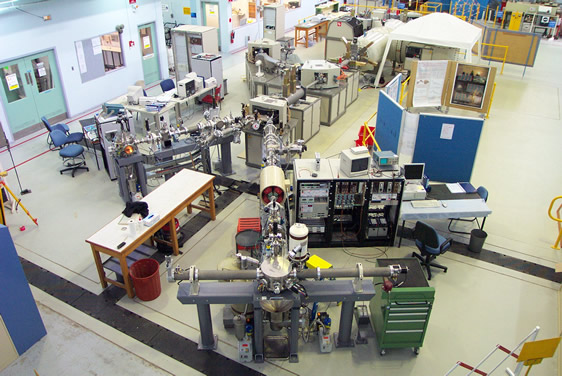The Australian Nuclear Science and Technology Organisation is an agency designed to deliver scientific services and advice to governmental, industrial and academia personnel in the field of Nuclear Physics.
| Energy | Particle Type | |
| STAR | Less than 4 MeV | Light to Medium Mass ions |
| ANTARES | 5 to 100 MeV | Ions |
Accelerators
ANTARES
The accelerator provides ion beams with energies from 5 to 100 MeV, depending on the ion species, with beam intensities up to a few microampers. Virtually any naturally occurring isotope can be produced as a beam, free from contamination of other isotope species or molecular ions.
ANTARES was commissioned in 1991 and has been continuously upgraded since then.
STAR
The 2MV Tandetron STAR accelerator can produce a wide range of light and medium weight ions, with energies from a few hundreds of keV to 4 MeV, and are used for a diverse range of activities in the fields of materials analysis, biological and environmental studies, as well as basic nuclear physics. The STAR accelerator also has an AMS 14C beam line used for routine radio carbon measurements.

Applications
Surface and bulk analysis of solid state materials, environmental pollution monitoring, archaeological artefact elemental determinations, studies of pigment composition in paintings, biological studies using tracer elements and studies of geological material.
Facilities on STAR Accelerator include:
- Broad beam IBA facility - Target chamber and data collection facility for simultaneous PIXE (proton-induced X-ray emission), PIGE (proton-induced gamma-ray emission) and RBS (Rutherford backscattering). Sample holders can take up to 60 samples in vacuum and measurement of samples is automated.
- Multi-Angle Detector Positioning System - XYZ Target Manipulator - UHV target chamber with charged particle detectors for depth profile measurements of light elements such as hydrogen, carbon and oxygen, using forward recoil and nuclear reaction techniques. These are used for measurement of water turnover in desert lizards using 18O as a biological tracer, depth profiling of ion implanted species in semiconductors.
Accelerated Mass Spectroscopy (AMS)
ANSTO's AMS capabilities contribute to national and international research in environmental science, climate change and archaeology. The AMS team is also focused on developing new techniques for AMS and isotope analysis, and in expanding and improving existing sample processing methods. AMS is able to separate and measure rare isotopes from a more abundant isotope with similar mass, eg 14C can be separated from the much more abundant 12C and measured at high sensitivity. This abundance sensitivity means that AMS can be used to measure a number of naturally-occurring, long-lived radioisotopes, which makes it a very useful technique for dating purposes.
